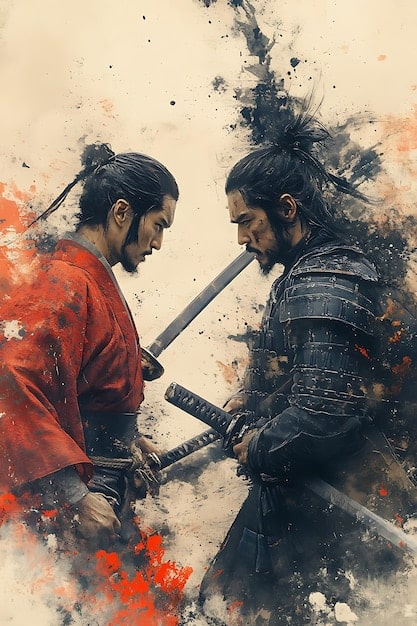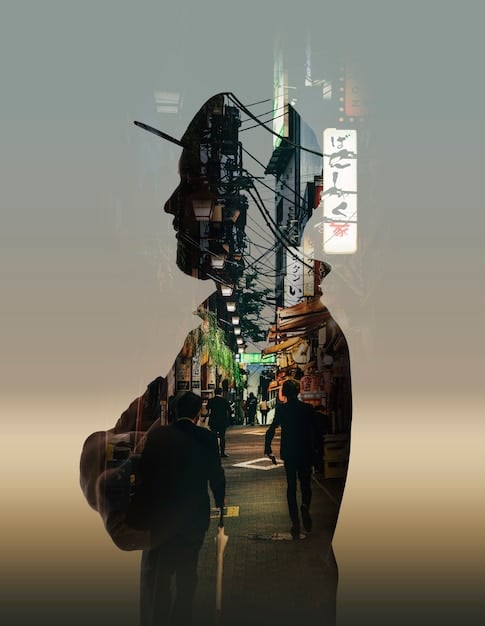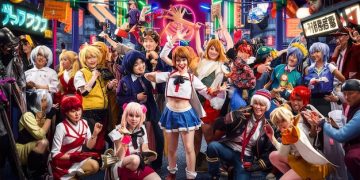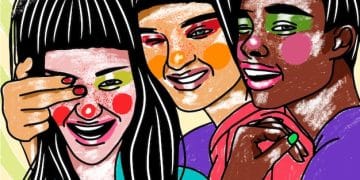Samurai to Salarymen: Seinen Manga Protagonist Analysis

From Samurai to Salarymen: A Comparative Analysis of Seinen Manga Protagonists explores the evolving archetypes in seinen manga, contrasting traditional samurai ideals with the modern salaryman’s struggles, reflecting societal shifts and their impact on character narratives.
Dive into the complex world of seinen manga as we explore From Samurai to Salarymen: A Comparative Analysis of Seinen Manga Protagonists, examining how these characters reflect Japan’s evolving societal values.
The Evolution of the Seinen Protagonist
Seinen manga, targeted towards older male audiences, often delves into complex themes and character development. The protagonists found within these series have evolved significantly over time, reflecting the changing landscape of Japanese society. From the noble samurai of feudal Japan to the overworked salaryman of modern times, these characters embody different values and struggles.
Understanding this evolution requires a closer look at the historical context and societal pressures that have shaped these protagonists. By examining their motivations, challenges, and relationships, we can gain a deeper appreciation for the narratives that resonate with seinen readers.
The Enduring Appeal of the Samurai
The samurai warrior, a figure steeped in honor and tradition, remains a popular archetype in seinen manga. Characters embodying the samurai spirit often face moral dilemmas and navigate conflicts between loyalty and personal ambition.
The Rise of the Salaryman in Manga
In contrast, the salaryman represents the modern Japanese worker, often depicted as facing intense pressure, long hours, and a sense of alienation. These characters grapple with issues of identity, purpose, and the pursuit of success in a corporate world.

- Samurai embody honor, discipline, and loyalty.
- Salarymen often struggle with work-life balance and identity.
- Both archetypes reflect different aspects of Japanese culture.
The shift from samurai to salaryman protagonists reflects a broader societal transition from feudalism to a modern, capitalist economy. This change has profound implications for individual identity and the values that are emphasized in Japanese society. Many seinen manga explore this contrast to great effect.
Bushido vs. Modern Corporate Values
The core values that define samurai and salarymen differ significantly, reflecting the distinct historical and societal contexts that shaped them. Understanding these differing value systems helps to appreciate the conflicts and challenges faced by protagonists representing these archetypes.
While the samurai code of Bushido emphasizes honor, self-sacrifice, and martial prowess, modern corporate values often prioritize efficiency, productivity, and conformity. This clash of values presents a rich source of narrative tension in seinen manga.
The Principles of Bushido
Bushido, the way of the warrior, emphasizes virtues such as loyalty, courage, and benevolence. Samurai were expected to live and die by these principles, prioritizing honor above all else.
The Demands of Corporate Culture
Modern corporate culture, on the other hand, often places a premium on teamwork, innovation, and achieving financial goals. Salarymen are expected to prioritize the needs of the company and conform to its expectations.

- Bushido prioritizes honor and self-sacrifice.
- Corporate culture emphasizes efficiency and conformity.
- The conflict between these values drives many seinen narratives.
The contrast between Bushido and modern corporate values highlights the tension between tradition and modernity in Japanese society. Seinen manga often explores this tension through characters who struggle to reconcile these conflicting values in their own lives. These deeper thematic explorations make the genre appealing to its mature audience.
Examples in Popular Seinen Manga
To illustrate the evolution of the seinen protagonist, it is helpful to examine specific examples from popular manga series. These examples showcase the different ways in which samurai and salarymen are portrayed and the challenges they face.
Consider the following manga, and analyze how their protagonists embody either the traditional samurai spirit or the struggles of the modern salaryman. These characters provide valuable insights into the evolving values and expectations of Japanese society.
“Vagabond”: A Samurai’s Journey
“Vagabond,” Takehiko Inoue’s masterpiece, depicts the life of Miyamoto Musashi, a legendary samurai. Musashi’s journey is one of self-discovery, as he strives to perfect his martial skills and find meaning in a world of violence.
“Aggretsuko”: The Salaryman’s Lament
In contrast, “Aggretsuko” follows Retsuko, a red panda who works in a dead-end office job and copes with her frustration by singing death metal karaoke. Retsuko’s struggles are relatable to many modern salarymen.
- “Vagabond” showcases the samurai’s pursuit of perfection.
- “Aggretsuko” reflects the frustrations of modern office life.
- These contrasting narratives highlight the evolution of the seinen protagonist.
“Vagabond” and “Aggretsuko” represent two distinct but equally compelling archetypes in seinen manga. By examining these and other examples, we can gain a deeper understanding of the evolving character of the genre and the cultural values it reflects. This understanding helps to contextualize complex issues within Japanese society.
Common Themes and Tropes
Despite the differences between samurai and salaryman protagonists, certain themes and tropes are commonly found in seinen manga. These recurring elements reflect the enduring concerns and anxieties of Japanese society.
Exploring themes like the search for identity, the burden of responsibility, and the struggle for survival can reveal deeper insights into the cultural relevance of seinen manga. These common threads connect seemingly disparate narratives and provide a framework for understanding the genre’s enduring appeal.
The Search for Identity
Many seinen protagonists grapple with questions of identity, as they seek to define themselves in a world that often demands conformity. This theme is particularly relevant to salarymen, who may feel lost in the corporate machine.
The Burden of Responsibility
Both samurai and salarymen often bear a heavy burden of responsibility, whether it be to their clan, their family, or their company. This burden can lead to stress, anxiety, and a sense of isolation.
- The search for identity is a central theme in many seinen manga.
- The burden of responsibility can be a source of conflict and stress.
- These themes reflect the anxieties of Japanese society.
By examining these common themes and tropes, we can gain a deeper appreciation for the complexities and nuances of seinen manga. These narratives offer valuable insights into the human condition and the challenges of navigating modern life. They also contribute to the broader discourse on societal values and individual agency.
The Influence of Historical and Societal Factors
The evolution of the seinen protagonist is closely linked to historical and societal factors. Changes in Japan’s political, economic, and cultural landscape have profoundly influenced the characters and narratives found in seinen manga.
Understanding the historical context is essential for interpreting the meaning and significance of these characters. From the decline of the samurai class to the rise of corporate capitalism, these historical shifts have shaped the values, beliefs, and aspirations of Japanese society, which in turn influences the genre.
The Decline of the Samurai Class
The Meiji Restoration in the late 19th century marked the end of the samurai class and the beginning of Japan’s modernization. This historical event had a profound impact on Japanese identity and the values that were emphasized in society.
The Rise of Corporate Capitalism
In the post-World War II era, Japan experienced rapid economic growth, driven by corporate capitalism. This economic boom led to the rise of the salaryman as a symbol of success and prosperity.
- The Meiji Restoration led to the decline of the samurai class.
- Corporate capitalism led to the rise of the salaryman.
- These historical shifts have shaped the evolution of the seinen protagonist.
By examining these historical and societal factors, we can gain a deeper understanding of the cultural forces that have shaped the world of seinen manga. These narratives often serve as a reflection and a critique of the values and expectations of Japanese society. In doing so, they engage readers in a dialogue about identity, purpose, and the meaning of life.
The Future of Seinen Protagonists
As Japanese society continues to evolve, so too will the characters and narratives found in seinen manga. The future of the seinen protagonist is likely to reflect the emerging challenges and opportunities facing Japan in the 21st century.
Considering the impact of globalization, technological advancements, and changing demographics can allow us to anticipate the themes and archetypes that will dominate the genre in the years to come. As societal issues evolve, manga will evolve to reflect them.
The Impact of Globalization
Globalization is bringing new influences and perspectives to Japanese society. This is likely to lead to more diverse and complex characters in seinen manga.
The Role of Technology
Technological advancements are transforming the way people live and work. Seinen manga may explore the impact of technology on identity, relationships, and the meaning of life. From AI overlords to the struggle for human connection, all will be represented.
- Globalization is likely to lead to more diverse characters.
- Technology may transform the way people live and work.
- The future of the seinen protagonist will reflect the emerging challenges facing Japan.
The future of the seinen manga protagonist is uncertain, but it is likely to be shaped by the forces of globalization, technology, and demographic change. These narratives will continue to provide valuable insights into the evolving values and expectations of Japanese society. As such, they will continue to resonate with readers both in Japan and around the world.
| Key Point | Brief Description |
|---|---|
| ⚔️ Samurai Ideals | Honor, loyalty, and self-sacrifice define the samurai archetype. |
| 🏢 Salaryman Struggles | Overwork, stress, and identity crises mark the salaryman’s journey. |
| 🔄 Societal Shift | From feudalism to corporate culture, values have significantly changed. |
| 💡 Future Trends | Globalization and technology will shape future protagonists. |
FAQ
▼
Seinen manga is a genre of manga marketed towards older male audiences. It often features more complex themes, mature content, and deeper character development than shonen manga.
▼
Common themes include the search for identity, the burden of responsibility, moral ambiguity, and the struggle for survival in a complex and often harsh world. They frequently mirror real life challenges.
▼
The seinen protagonist has evolved from traditional figures like samurai to modern archetypes like the salaryman, reflecting societal changes and the evolving values of Japanese culture.
▼
Bushido is the traditional code of conduct for samurai, emphasizing virtues such as honor, loyalty, self-sacrifice, and martial prowess. It heavily influences depictions of samurai in pop culture.
▼
Historical events, such as the Meiji Restoration and the rise of corporate capitalism, have profoundly influenced the characters and narratives in seinen manga, reflecting societal shifts and cultural values.
Conclusion
In conclusion, the journey From Samurai to Salarymen: A Comparative Analysis of Seinen Manga Protagonists reveals a compelling narrative of cultural evolution within Japan. The shift from the honorable samurai to the diligent salaryman reflects profound societal transformations, impacting values and individual aspirations. By exploring these archetypes, seinen manga offers valuable insights into Japanese identity and the struggles of modern life, promising continued relevance in the genre’s future.





